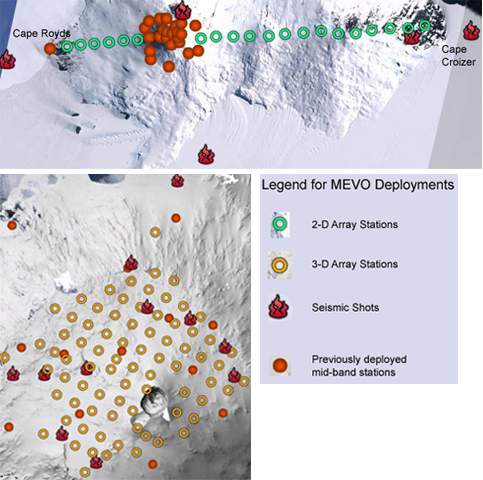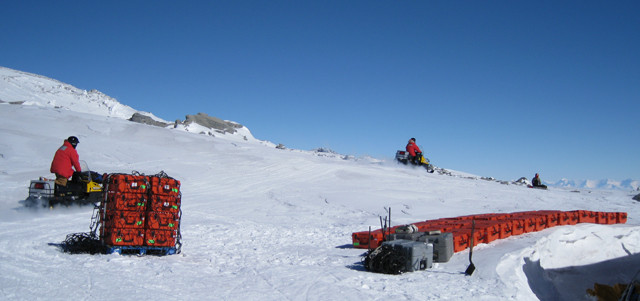Mt. Erebus Volcano Observatory (MEVO) Experiment 2008-2009
Brian Bonnett installs a MEVO station.
The PASSCAL Polar Program supported MEVO experiment was a seismic refraction experiment designed to image the magma chamber of the Mt. Erebus volcano in Antarctica. The Principle Investigators (PI's) and primary researchers involved with this experiment were Dr. Phillip Kyle, Dr. Richard Aster, Dr. Catherine Snelson, Dr. Daria Zandomeneghi and Hunter Knox. The project was funded through a grant awarded to the PI's by the National Science Foundation Office of Polar Programs. A paper that discusses this experiment has been published in EOS, Transactions, American Geophysical Union entitled: “Seismic Tomography of Erebus Volcano, Antarctica” authored by Zandomeneghi et al. (See the end of the article for details.)
Field Area:
The field area for this experiment was Mt. Erebus, Ross Island, Antarctica. The stations were arranged for two experiment types which were designed by the researchers. The first was a long a 2-D line of 20 stations from Cape Royds to Cape Croizer. The second was in a 3-D grid of 79 stations over the summit of Mt. Erebus. The chemical blast seismic sources for the 2-D array were located at each end of the array and one fan shot in the middle of the array. The chemical blast seismic sources for the 3-D array were located at various points within the 3-D array for optimal ray path coverage.

Logistics:
All 100 systems were tested and pre-programmed in Crary Lab at McMurdo Station. A team of 2 people in A-star helicopter deployed the stations for the 2-D array. Bell 212 helicopters flew all of the equipment for the 3-D array to the Lower Erebus Hut and other sites on Mt. Erebus. Several teams of 2 people on snowmobiles deployed stations for the 3-D array. A combination of snowmobiles, piston bullies and helicopters were used to bring drilling equipment, blast material and personnel to the seismic shot sites. Personnel from the research group and PASSCAL participated in the logistics for this experiment.

2-D installation by A-Star, Summit site installation by snowmobile, Delivery by 212
Equipment:
- 100 RT130 Dataloggers with GPS for timing
- 100 L-28-3D High Frequency Sensors
- 100 MEVO boxes with 10W solar panels
- 32 or 58 Ahr batteries (Batteries were obtained by the PI, Phil Kyle, however the PASSCAL Polar Program can obtain batteries for similar experiments.)
Dr. Phillip Kyle displays the equipment of a MEVO station.
The MEVO experiment was the first use of the newly designed Rapid Deployment Polar enclosures, nicknamed MEVO boxes. They were designed so that all of the equipment, except the sensor, that is needed for a short-duration deployment could be packed in one easily carried case. The MEVO boxes have room for a datalogger, 58 Ahr battery, GPS/antenna and cable, small power controller and 10W solar panel. The box has a connector on the outside to connect to the solar panel. The solar panel, when deployed, attaches to the top of the box. The MEVO box also has a through hole for the sensor cable. The average deployment time of a MEVO station on this experiment was less than 20 minutes at a deployment site.
Project Comments (from the Researchers):
In a preliminary examination of the data and log files, the researchers found that the summit shots were recorded over the entire 3-D array and some flank stations. In the 2-D array, they found the western most shot was recorded with high quality by all of the 2-D line including the furthest eastern most stations. The researchers involved have determined that the data obtained will provide a 2-D P-wave velocity model for Ross Island and a detailed 3-D image for the Mt. Erebus summit. More information on this experiment and Mt. Erebus can be found at the Mt. Erebus Volcano Observatory website.

Photo by: Bob Greschke
Field Images
Pictures taken during this experiment from Pnina Miller and Bob Greschke.
References:
Zandomeneghi, D., Kyle, P., Miller, P., Snelson, C., and Aster, R., (2010) Seismic Tomography of Erebus Volcano, Antarctica, EOS Transactions, AGU, 91 (6) 53-55.
Chaput, J., Zandomeneghi, D., Aster, R., Knox, H., Kyle, P., Imaging of Erebus volcano using body wave seismic interferometry of Strombolian eruption coda, Geophys. Res. Lett., 39, (7), L07304, doi:/10.1029/2012GL050956, 2012.
- Home
- General Information
- Instrumentation
- Dataloggers
- Sensors
- All-In-One Systems
- Power Systems
- Field Procedures
- Controlled Sources
- Seismic Source Facility
- Magnetotelluric Systems at PASSCAL
- Ground Penetrating Radar
- Power and Memory Calculations Form
- Data Archiving
- Apply for a PI Account
- Experiment Scheduling
- Polar
- Important Hardware/Software Notes
- USArray
- Software


